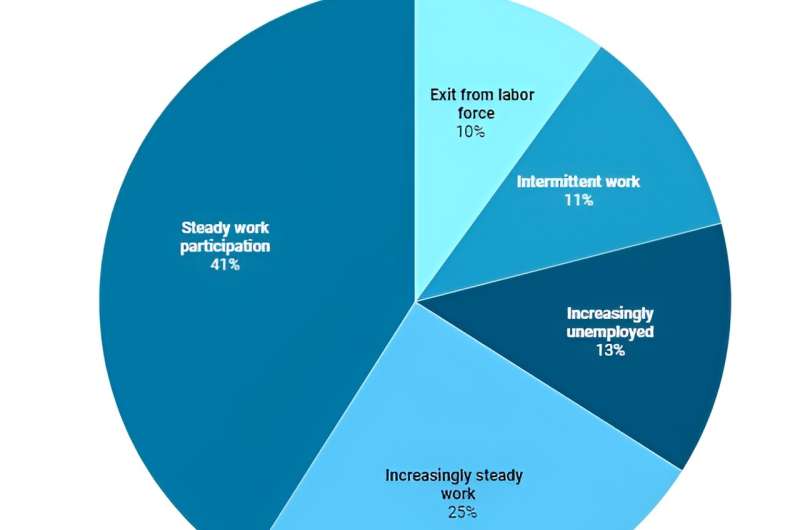The myth of men's full-time employment

Men's employment in the U.S. reached a 20-year high in 2023, with of men ages 25 to 54 in the workforce, according to . This supports the —some might say stereotype—that full-time employment is the norm for American men.
Yet examining employment at a single point in time leaves out important information about whether people are able to maintain stable work. of male baby boomers' working lives—spanning more than two decades—tells a very different story.
In fact, men's labor force participation has been since the 1970s, and workers are experiencing greater labor market precarity—that is, shorter job spells, greater job insecurity and more long-term unemployment.
In our research in the study of over time, we have that most women "opt out" of the workforce, establishing that the majority of women work steadily and full time. That led us to suspect that the picture of men's employment could also be incomplete.
To understand these long-term trends, we studied data from about 4,500 men collected over more than 25 years. We were looking for patterns in the amount of time these men spent employed, unemployed and looking for work, and out of the workforce and not looking for work.
We were surprised to find that of late baby boomer men—those who were between 14 and 21 years old in 1979—worked steadily and continuously, which we defined as working almost every week of the year between ages 27 and 49. This is a cohort of men who were widely thought to have taken a "" approach to work: entering the labor market when they finished their schooling and remaining employed until retirement.
We found most men didn't fit this stereotype. About a quarter didn't reach steady employment until they were nearly 50. Another quarter either found themselves increasingly unemployed and out of work as they aged or able to find only intermittent work. Finally, a smaller group of men left the labor market entirely—some leaving paid work at relatively young ages, while others leaving as they reached middle age.
Problems with precarity
We don't know exactly why these men followed such a wide range of work patterns during what economists call their "prime earning years." But we think increasing labor market precarity—which researchers say is driven in large part by and —played a big role.
For example, we found that men who worked as "" or in "" were at greater risk of unemployment. These are jobs that provided our own grandfathers with good, well-paying work, but they are also jobs that have become since the 1970s.
We also found that men were at greater risk if they lived in counties with a higher unemployment rate or in states with more unionized jobs when they first entered the labor market. That latter point likely put them at greater risk of job loss in the 1980s and 1990s.
Men who experienced unemployment, more job turnover before the age of 25 or transportation barriers to finding a good job also followed less steady work patterns, suggesting that they may have been forced to take "bad jobs" that provided fewer opportunities to move up the ladder or to earn a living wage.
Our findings paint a troubling portrait of employment in America. If this kind of unsteady employment characterizes the work patterns of the baby-boom generation, what awaits those of us who follow them? Is there anything we can do about it?
Ideas for improvement
The good news is there are solutions for workers, employers and the federal government. Our that a college degree could protect men from the risk of unemployment or time out of work. The government can support this goal by , as the current administration has .
For employers, our findings suggest that making work less precarious—in other words, making it more stable, with better pay and more schedule control—would be a win-win proposition. Research suggests that employers consistently of losing employees. Given how hard it's been for employers to stay fully staffed—especially in retail and service work—making jobs more appealing to workers could pay off in terms of retention.
Walmart, for instance, has for its workers. Such moves have been shown to benefit both the employers, through the , and the employees, through improved work conditions and work benefits.
The government could also implement policy changes, such as the , to promote workers' right to unionization, since unionization is consistently linked to and .
We don't think the U.S. needs the jobs that our grandfathers held to return; instead, it needs to turn today's available jobs into good jobs. The recent National Labor Relations Board "" ruling, for example, should do this by making it easier for workers at national chains to unionize across franchises, which could improve the working conditions of millions of people in the service industry.
Finally, government can take action to make unemployment a less miserable experience. Our findings, both here and elsewhere, suggest that unemployment does considerable harm to . system by expanding eligibility and creating progressive wage replacement rates may make it easier for workers to , which suggests could help them return to stable employment.
Our findings are the canary in a coal mine. They suggest that for future generations, steady employment may be a thing of the past. But the good news is that we can heed the warning and take steps to give everyone access to better jobs and more stable employment.
Provided by The Conversation
This article is republished from under a Creative Commons license. Read the .![]()




















